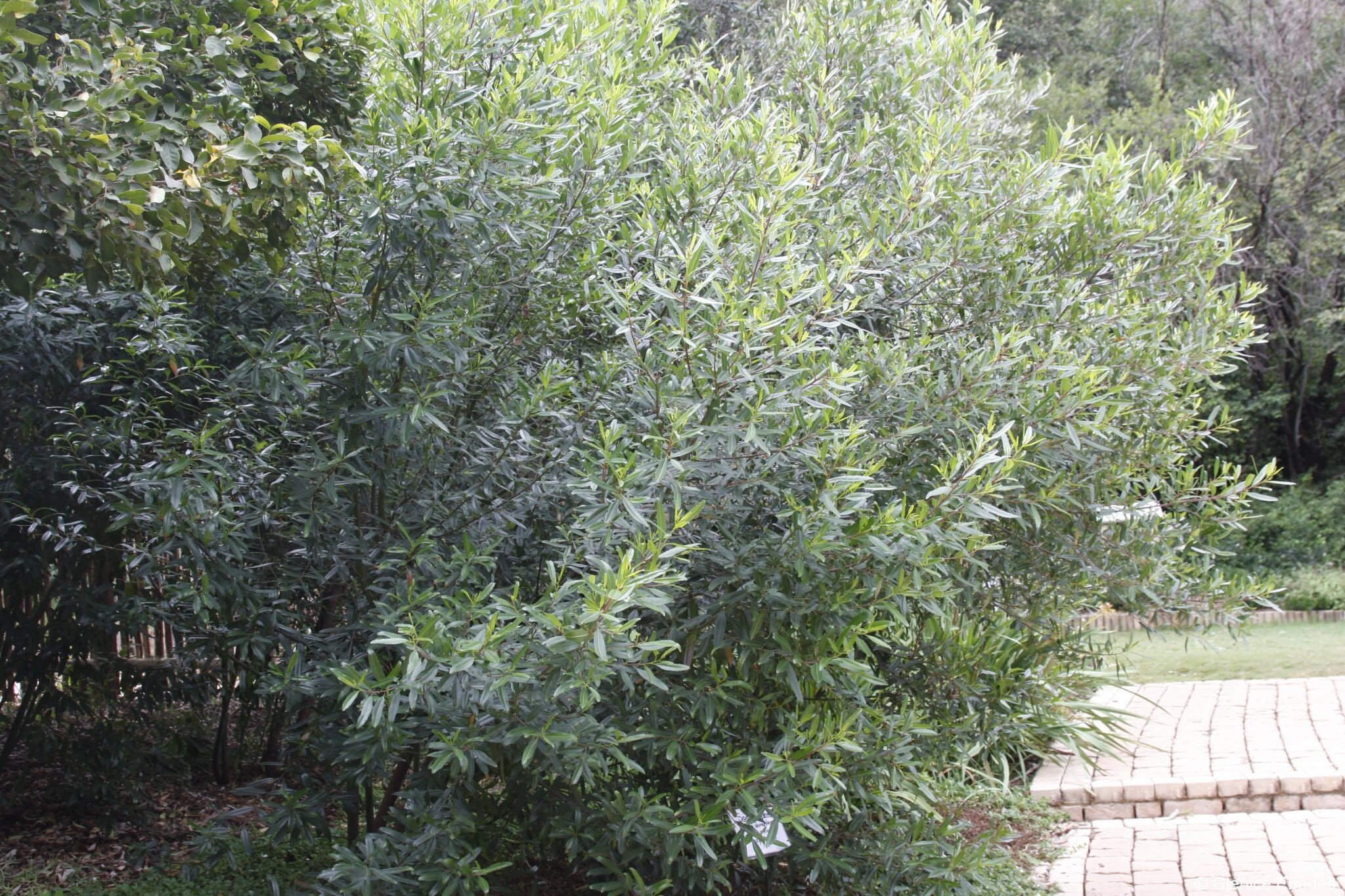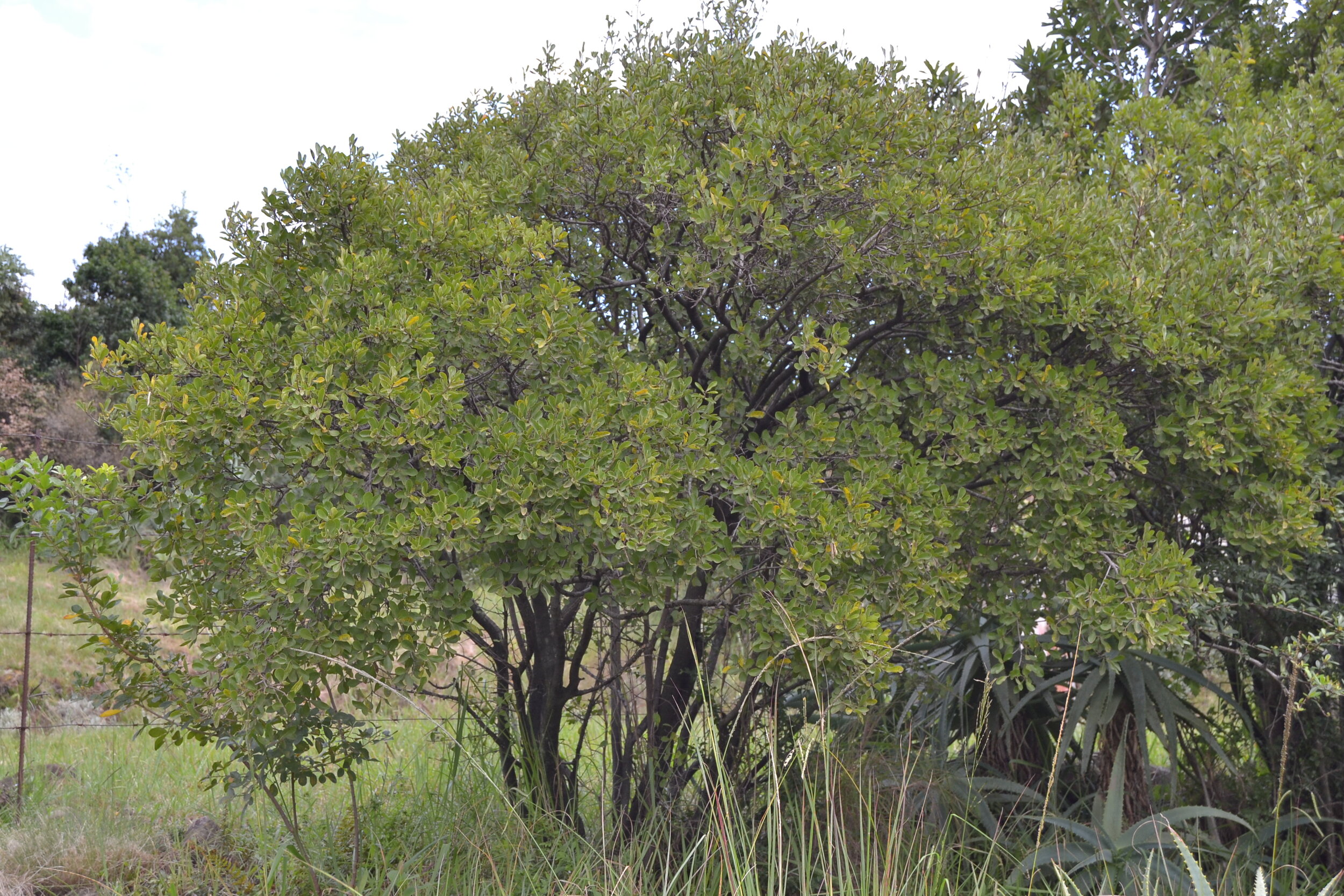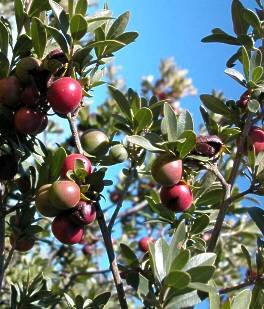Trees for Screening
Many landscapes require screening between the edges of a property for privacy or the addition of height for softening of buildings. Mostly you would be looking for evergreen trees with attractive foliage and non-aggressive roots. When designing a tree screen I like to use a combination of tree heights and foliage texture. Here are some lovely indigenous screening trees to consider:
1. Olea europaea subsp. africana (Olive Tree)
Olea europaea subsp. africana is a neatly shaped, hardy, evergreen tree with a dense spreading crown (9 x 12 m) of glossy grey-green to dark-green foliage. Leaves are grey-green to dark-green above and greyish below. The rough, grey bark sometimes peels off in strips. Sprays of tiny, lightly scented white to greenish flowers (October to February) are followed (March to July) by small, spherical, thinly fleshy fruits (either sweet or sour) which ripen purple-black. The Latin name for olive is olea; europaea = from Europe, and africana = from Africa. Don't plant it too close to walls, patios or swimming pools, the root system can sometimes be aggressive. (http://pza.sanbi.org/olea-europaea-subsp-africana)
Olea africana (Image from SunTrees Nursery)
2. Buddleja saligna (False Olive)
Buddleja saligna is a medium sized tree usually 4 to 5 metres in Highveld areas. This fast growing tree is an excellent, quick screen plant. It grows up to 800mm per year. Use it as a pioneer tree for your forest garden. It also makes a very good clipped hedge. It is evergreen, frost hardy and drought resistant and the masses of flowers make a lovely spring and summer show. It will grow in most soils but added compost will improve performance. It may need cutting back after flowering to keep tidy. The false olive does not have an aggressive root system. The flowers attract insects (especially moths) and therefore insect feeding birds such as Robins and Apalises to the garden. (http://pza.sanbi.org/buddleja-saligna)
Buddleja saligna (Image from CJM Nursery)
3. Ilex mitis (Cape Holly)
Ilex mitis is a hardy, small to medium sized, evergreen tree with almost white bark. It has a graceful rounded crown of glossy, dark green leaves that are purplish-red when they first flush.
Massed clusters of small, sweetly scented, white flowers are borne from October to February. (Male and female flowers on separate trees, therefore only female plants bear fruit). These are followed by tightly packed decorative red berries that attract flocks of fruit eating birds. It grows better in moist conditions near water but can withstand dry conditions. With its beautiful shape it makes a good avenue tree. Although this beautiful rounded tree can grow to huge proportions in forest conditions, it is normally a small to medium sized tree. The leaves are used as a soap substitute. Size 3 to 8m (Information from Random Harvest Website)
Ilex mitis (Cape Holly) Image from Just Trees Nursery
4. Vepris lanceolata (Ironwood)
Vepris lanceolata is a hardy, evergreen, very attractive tree with apple green foliage. It blooms with a myriad of small, white flowers from December to January, which give the tree a lacy look. The black berries ripen throughout the autumn and winter and are an important source of food for the birds. The tree is host to the Citrus Swallowtail Butterflies. A beautifully shaped tree and a very good garden subject that can be used as a screen or container plant for outdoors or indoors. The non-aggressive root system makes it ideal for smaller gardens. The timber is even-grained and white. It has many medicinal uses. Size 5 to 10m (Information from Random Harvest Website)
Vepris lanceolata (Ironwood) photographed in Random Harvest Nursery
5. Rapanea melanophloes (Cape Beech)
Rapanea melanophloes is a hardy, small to medium sized, evergreen tree with dark leaves that have a purplish cast to them. It also has really attractive bark. The small greenish-white flowers from May to July attract insects and bees. These are followed by small purple fruits that are borne in profusion close to the stems which attract fruit eating birds. A good garden subject and a useful addition to screen planting with its unusual colour foliage. The wood is used for making furniture and violins and has many magical and medicinal uses. Size 4 to 10m (information from Random Harvest Website)
6. Noltea africana
Noltea africana is a very hardy, evergreen, very fast growing, small to medium sized tree. The glossy leaves are darker above and paler underneath, and have purple petioles. The branchlets are also purplish-red. The flowers are pretty, small, white sprays borne in the axils of the leaves from August to September. The black seeds are encased in a three-lobed, brown woody capsule that splits to release them when ripe. A decorative tree that is ideal for the smaller garden but should be kept as a single stem. Grows well in sun and semi-shade. A good tree to plant for a quick screen. When twigs and leaves are rubbed in water it becomes soapy. Size 2 to 6m (Information from Random Harvest Website)
Noltea africana (Soapwood) plantbook.co.za
7. Loxostylis alata (Tarwood)
A small, well-shaped tree with glossy foliage tinged with red when young and masses of white flowers in early summer, and if the tree is a female it has showy pinkish red fruits. Tarwoods are evergreen, ornamental trees which will grow in a wide range of ecological habitats. This tree closely resembles the Brazilian pepper tree, Schinus terebinthifolius of the same family, which does not have the characteristic red sepals. This is a very attractive small tree or large shrub for gardens. It is also useful for screening and boundary plantings. It grows to 6 m or higher in favorable conditions, but can form a large, dense shrub. Other recommended trees in this family are the red currant (Rhus chirindensis), wild-plum (Harpephyllum caffrum) and the marula (Sclerocarya birrea). (http://pza.sanbi.org/loxostylis-alata)
Loxostylis alata (Tarwood) from SANBI Website
8. Cryptocarya traansvaalensis (Mountain Wild Quince)
Cryptocarya transvaalensis is a hardy, evergreen large tree with beautiful glossy dark green foliage. The leaves are blue-green below. The inconspicuous flowers are borne in the axils of the leaves from December to February. These are followed by glossy red to purple berries that are decorative and attract fruit eating birds to the garden. This species is declining as the bark is used for medicinal purposes. It makes a beautiful container plant and if you have the space a magnificent specimen tree. It stays smaller when grown in full sun. Size up to 12m (Information from Random Harvest Website)
There are many many other screening trees that can be used so don’t let this list limit you!















